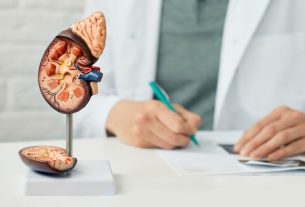An inflamed ear can arise due to injuries, the introduction of objects into the ear, water entry or infections caused by viruses, bacteria or fungi.
Ear inflammation, when identified and treated correctly, does not represent a risk, but is only uncomfortable, as it causes pain, itching in the ear, decreased hearing and, in some cases, the release of a secretion from the ear.
Despite being easily resolved, ear inflammation must be evaluated and treated by an otorhinolaryngologist, especially when the pain lasts more than two days, there is a feeling of dizziness or vertigo and the pain in the ear is very intense, as it may be a sign of inflammation. or ear infection.

Main causes of ear inflammation
The main causes of ear inflammation are:
1. Otitis externa
Otitis externa is the most common cause of ear inflammation, being more common in babies and children who spend a lot of time at the beach or in the pool, for example.
This is because heat and humidity favor the proliferation of bacteria, leading to inflammation and causing symptoms such as pain and itching and, in some cases, the presence of pus in the ear.
What to do: Treatment is normally carried out with the use of medications to reduce inflammation, such as dipyrone or ibuprofen, but if the presence of secretions is verified, the doctor may also recommend the use of antibiotics. Find out which are the most used remedies for ear pain.
Don’t ignore the signs your body is giving you!
2. Otitis media
Otitis media corresponds to inflammation of the ear that usually appears after the flu or sinusitis attacks, and is characterized by the presence of secretion in the ear, decreased hearing, redness and fever.
As it is the result of a flu or sinus attack, otitis media can be caused by viruses, bacteria, fungi or allergies. Learn more about otitis media.
What to do: the Treatment is usually done with the use of analgesics and anti-inflammatories. If otitis media is caused by an infectious agent, the use of antibiotics, usually Amoxicillin, for 5 to 10 days may also be recommended. See the main remedies for inflamed ears.
3. Injury during ear cleaning
Cleaning the ear with a cotton swab can push out the earwax and even rupture the eardrum, which causes pain and secretion in the ear.
What to do: To properly clean your ears and thus prevent infections, you can wipe the corner of the towel over the entire ear after bathing or place two drops of almond oil inside the ear to soften the wax, and then, with the help of From a syringe, put a little saline solution inside the ear and turn the head slowly so that the liquid comes out.
It is important to avoid cleaning your ears with a cotton swab and introducing foreign objects into this cavity, as infection can result in serious health problems. Learn how to clean your ears properly.
4. Presence of objects inside the ear
The presence of objects in the ear, such as buttons, small toys or food, is more common in babies and is usually accidental. The presence of foreign bodies in the ear leads to inflammation, causing pain, itching and the release of secretion in the ear.
What to do: If it is observed that the baby has accidentally placed objects in the ear, it is important to go to the pediatrician or otolaryngologist so that the object can be identified and removed. In more serious cases, surgical removal of the object may be necessary. It is not recommended to try the object at home alone as this may push the object further and cause complications.
5. Eczema
Eczema is an inflammation of the skin, which affects the skin’s protective barrier, and can appear on the skin of any part of the body, including the ears, and affect the lobes, shell and opening of the ears, as well as the ear canal. external or the eardrum, causing symptoms such as dry skin, itching, redness, peeling skin and cracking of the skin.
Furthermore, when it affects the ear canal or eardrum, eczema can cause ear pain, due to inflammation and irritation of these structures, and in some cases, it can affect hearing.
What to do: The treatment of eczema is carried out by an otorhinolaryngologist, and the use of corticosteroids in the form of ointments for the external parts of the ears, or otological corticosteroid solutions, is normally recommended, if the eczema has affected the ear canal or eardrum. See how eczema is treated.
6. Miringite
Myringitis is an inflammation of the tympanic membrane, which separates the outer ear from the middle ear, leading to the appearance of symptoms, such as a feeling of heaviness in the ear or mild ear pain, which begin suddenly and last about 24 to 48 hours, and in some cases there may also be fever and decreased hearing.
Generally, myringitis is caused by bacterial or viral infections of the respiratory tract, which can affect the middle ear and cause inflammation of the tympanic membrane, but it can also arise due to trauma or direct blows to the ear, accidental injury when cleaning the ear, or changes in atmospheric pressure during a plane journey, for example, and affect children and adults at any age.
What to do: The treatment of myringitis is carried out by an otorhinolaryngologist who must recommend the use of antibiotics to combat the infection and analgesics to relieve pain. See all treatment options for myringitis.
7. Ear barotrauma
Ear barotrauma, also called barotitis media, is caused by a difference in pressure between the ear canal and the external environment, due to sudden changes in altitude, such as during a plane trip or by quickly ascending or descending mountains at high altitudes. , for example.
These pressure differences cause the Eustachian tube or auditory tube, which connects the tympanic cavity to the back of the nasal cavity, to open to balance the pressure in the middle ear.
When the Eustachian tube is partially or completely obstructed, as in cases of colds, allergies, infections or scars, air cannot circulate properly in the middle ear, which can cause ear pain, tinnitus, or a sensation that the ear is closed. covered, and in more serious cases, otitis, rupture of the eardrum or discharge from the ear.
What to do: One option to alleviate discomfort and avoid ear pain caused by the difference in pressure is to chew gum or yawn at these times. In the case of a baby, breastfeeding, giving a bottle of water or a pacifier are good ways to relieve pain. Check out more tips for relieving earaches on the plane.
In more serious cases, treatment must be carried out by an otorhinolaryngologist, who may recommend the use of analgesic or anti-inflammatory medications to relieve pain and discomfort in the ear, corticosteroids to reduce inflammation, or antibiotics in the case of infections. .
8. Surfer’s ear
Surfer’s ear, known scientifically as exostosis of the external auditory canal, is a disease caused by frequent exposure to cold water, which leads to irritation and inflammation of the external auditory canal, which stimulates the formation of a small benign bone in the tympanic ring.
Generally, in the initial stages, this condition does not cause symptoms, but as the disease progresses, it can cause chronic otitis externa, a feeling of stuffiness in the ear, decreased hearing, discharge in the ear canal or a feeling of water trapped inside the ear.
Despite being called surfer’s ear, exostosis of the external ear canal can also appear in people who are frequently exposed to cold water, such as swimmers, canoeists, divers or sailors, for example.
What to do: Surfer’s ear treatment is carried out by an otorhinolaryngologist and generally involves cleaning the ear to remove wax, antibiotics in cases of infections, or surgery to remove the bone formed in the tympanic ring.
When to go to the doctor
It is important to go to the otorhinolaryngologist when ear pain lasts more than 2 days and there is the presence of some of the following symptoms:
- Decreased hearing capacity;
- Fever;
- Feeling of dizziness or vertigo;
- Whitish or yellowish secretion in the ear with a bad smell;
- Very intense ear pain.
In the case of children, the symptoms are noticed based on their behavior, which can be observed in the case of ear pain, irritability, agitation, loss of appetite, the baby starts to put his hand on his ear several times and tends to shake his head towards the ear. side several times. See how to identify ear pain in babies.

Sign up for our newsletter and stay up to date with exclusive news
that can transform your routine!
Warning: Undefined array key "title" in /home/storelat/public_html/wp-content/plugins/link-whisper-premium/templates/frontend/related-posts.php on line 12
Warning: Undefined array key "title_tag" in /home/storelat/public_html/wp-content/plugins/link-whisper-premium/templates/frontend/related-posts.php on line 13



